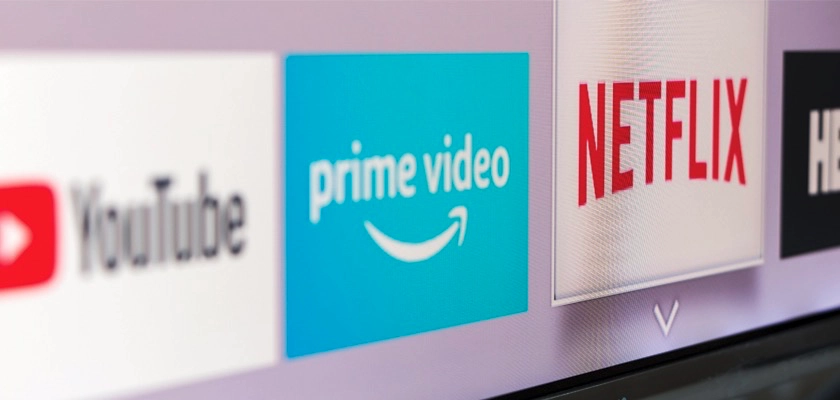Streamers Face Challenges as Competition Explodes | October 2022
Though consumers have more choices than ever when it comes to in-home entertainment, streaming providers face more challenges than ever.

Without a doubt, streaming competition has exploded in recent years. Netflix, once the clear favorite in the streaming business, has plenty of competitors keeping it company. Netflix, Disney+, Amazon Prime Video, HBO Max, Hulu, Discovery+, Apple TV+, Peacock, and Paramount+ are just a few of the major streaming providers in the United States. Though consumers have more choices than ever when it comes to in-home entertainment, streaming providers face more challenges than ever.
A brief overview of the major players
After years of DVD-by-mail renting, Netflix began streaming in 2007. Netflix made a big move in 2013 with the introduction of original programming. Amazon Prime Video was hot on Netflix’s heels. It first launched in 2006 as a digital purchase or rental service. In 2011, it added a library of free movies and TV shows for Amazon Prime members. The same year Netflix introduced original content for the first time, Amazon did the same.
When Hulu launched in 2007, the platform was a joint venture between News Corporation and NBC Universal that gave consumers access to free, ad-supported content from select networks. A year after launching a subscription tier, Hulu introduced original content in 2011. In 2017, Hulu became the first streaming platform to introduce live television streaming. In 2019, The Walt Disney Company bought a controlling interest in Hulu.
Apple TV+ launched in 2019, exclusively featuring original content. However, due to the COVID-19 pandemic in 2020, the platform was forced to quickly change its product strategy. Production was halted on new projects, forcing the company to fill its back catalog with content from other sources.
Disney+ also launched in 2019. Unlike Apple, the pandemic did not hinder Disney’s content strategy because of the company’s massive back catalog. Additionally, unlike Netflix, which took years to expand internationally, Disney already had extensive knowledge of international marketing and established connections in the entertainment industry worldwide.
People are watching more than ever
People are watching more content than ever, but it’s spread across more platforms. While consumers have more choices than ever, the market is also more fragmented than ever.
What consumers watch affects how consumers watch it. For instance, people watch live sports and live news broadcasts. This type of content is helping sustain traditional cable and broadcast television.
Choice leads to challenges
The traditional television model can be thought of as “appointment viewing” since viewers have to tune in at a certain time. Advertisers like this type of content where people are all gathered to watch one thing. On the flip side, with streaming, viewership is spread out across many different titles. More choice for streaming viewers has resulted in more challenges for streaming platforms and advertisers.
Streaming platforms cut back
Netflix has grown steadily for years, but its seemingly endless growth has slowed. This year, the company lost 200,000 subscribers in its first quarter and had to lay off 300 employees to reduce costs.
There is a limit to the number of services viewers are willing to pay for. According to Deloitte, the average viewer is subscribed to 3 to 4 streaming services.
Advertising on streaming platforms may change
When streaming first became popular, one of the perks for viewers was no longer having to watch advertisements, or no longer having to watch as many as traditional television. But now, every major streaming provider, including Netflix, is set to launch advertising in some way, shape, or form. Several major players have ad-supported versions that are free or less expensive than higher service tiers.
The way streaming works today, it’s much harder for streaming platforms to make money than it was for traditional television because the customer acquisition cost is higher.
Some experts expect to see more consolidation in the streaming landscape and more streaming platforms acting like traditional television networks.
In the Classroom
This article can be used to discuss the nature of competition (Chapter 1: The Dynamics of Business and Economics).
Discussion Questions
How did Hulu set itself apart from other streaming platforms?
Why has more choice created challenges for streaming platforms?
Why was Disney able to expand internationally faster than Netflix?
This article was developed with the support of Kelsey Reddick for and under the direction of O.C. Ferrell, Linda Ferrell, and Geoff Hirt.
Sources
Benjamin Mayo, "Bloomberg: Apple TV+ Tops 10 Million Subscribers, Company Buying TV Show and Movie Back Catalog to Expand Service," 9to5 Mac, May 19, 2020, https://9to5mac.com/2020/05/19/apple-tv-plus-back-catalog-subscribers/
"Competition TV: The Battle of Streaming Services," CBS News, September 25, 2022, https://www.cbsnews.com/video/competition-tv-the-battle-of-streaming-services/
Dan Moskowitz, "Who Are Netflix's Main Competitors?" Investopedia, May 16, 2020, https://www.investopedia.com/articles/markets/051215/who-are-netflixs-main-competitors-nflx.asp
Julia Alexander, "Disney Plus Surpasses 50 Million Subscribers," The Verge, April 8, 2020, https://www.theverge.com/2020/4/8/21214236/disney-plus-50-million-subscribers-international-europe-india-netflix



